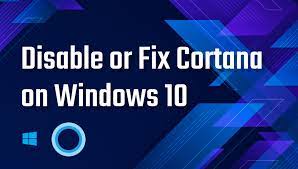
In the ever-evolving landscape of Windows 10, Cortana has become a staple feature for many users, offering assistance through voice commands, reminders, and more. However, there are times when you might find Cortana less helpful and more of a distraction, or perhaps you're experiencing issues with the feature. Whether you're looking to disable Cortana for a quieter computing experience or fix common problems, this article will guide you through the necessary steps.
Disabling Cortana
Option 1: Through Settings
Access Settings: Click on the Start menu, and then click the gear icon to open Settings.
Navigate to Cortana: In the Settings window, find and select "Cortana".
Adjust Permissions: Look for permissions settings or options that say "Talk to Cortana" and adjust these settings to disable listening and responses.
Sign Out: For a more complete disable, you might also need to sign out of your Microsoft account within Cortana's settings.
Option 2: Editing the Registry (Advanced Users)
Warning: Editing the registry can be risky if not done correctly. Always back up your registry before making changes.
Open Registry Editor: Press Windows Key + R, type regedit, and press Enter.
Navigate to the Cortana Key: Go to HKEY_LOCAL_MACHINE\SOFTWARE\Policies\Microsoft\Windows\Windows Search.
Create a New DWORD: If it doesn't already exist, right-click on Windows Search, select New > DWORD (32-bit) Value, and name it AllowCortana.
Set Value to 0: Double-click on AllowCortana and set its value to 0 to disable Cortana.
Restart Your Computer: For the changes to take effect, you'll need to restart your PC.
Fixing Common Cortana Issues
If Cortana is not functioning as expected, here are a few steps to troubleshoot and resolve common issues:
1. Check for Windows Updates: Ensure your Windows 10 is up to date as updates can fix bugs and improve Cortana’s functionality.
Go to Settings > Update & Security > Windows Update.
Click 'Check for updates'.
2. Restart Cortana Process:
Open Task Manager (CTRL+SHIFT+ESC).
Find Cortana in the list, right-click, and choose 'End Task'. Cortana will restart itself automatically.
3. Reinstall Cortana:
Open PowerShell as Administrator: Right-click the Start button and choose "Windows PowerShell (Admin)".
4. Enter the following command: Get-AppXPackage -AllUsers | Foreach {Add-AppxPackage -DisableDevelopmentMode -Register "$($_.InstallLocation)\AppXManifest.xml"}. This will reinstall and re-register Cortana.
4. Check Microphone Settings: If Cortana can't hear you, make sure your microphone is set up correctly in Windows Settings under System > Sound.
5. Reset Your PC: As a last resort, you can reset Windows 10, keeping your files but reinstalling the operating system. Go to Settings > Update & Security > Recovery, and choose "Get started" under Reset this PC.
Conclusion
Whether you're seeking to disable Cortana to streamline your Windows 10 experience or troubleshooting to get the assistant back on track, these steps should help. Remember, while disabling Cortana can free up resources and reduce distractions, Cortana's features are designed to assist with daily tasks, so consider your needs before turning it off. Always proceed with caution when making system-level changes, especially when editing the registry or resetting your PC.